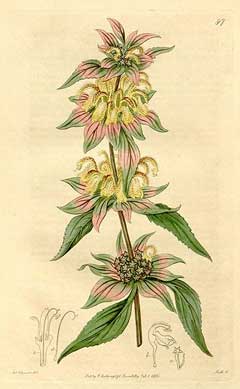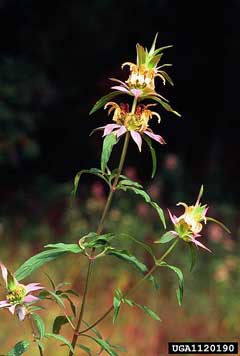 |
|
The botanical register vol. 1 tabl. 87 from www.botanicus.org |
 |
| www.forestryimages.org |
Translate this page:
Summary
Physical Characteristics

 Monarda punctata is a ANNUAL/PERENNIAL growing to 0.8 m (2ft 7in) by 0.4 m (1ft 4in).
Monarda punctata is a ANNUAL/PERENNIAL growing to 0.8 m (2ft 7in) by 0.4 m (1ft 4in).
See above for USDA hardiness. It is hardy to UK zone 6. It is in flower from July to September. The species is hermaphrodite (has both male and female organs) and is pollinated by Bees. The plant is self-fertile.
It is noted for attracting wildlife.
Suitable for: light (sandy), medium (loamy) and heavy (clay) soils and can grow in heavy clay soil. Suitable pH: mildly acid, neutral and basic (mildly alkaline) soils. It can grow in semi-shade (light woodland) or no shade. It prefers dry or moist soil.
UK Hardiness Map
US Hardiness Map
Synonyms
Plant Habitats
Cultivated Beds;
Edible Uses
Edible Parts:
Edible Uses: Condiment Tea
Leaves - raw or cooked. A strong aromatic taste, they are used as a flavouring in salads and cooked foods, and also as an aromatic tea[183].
References More on Edible Uses
Medicinal Uses
Plants For A Future can not take any responsibility for any adverse effects from the use of plants. Always seek advice from a professional before using a plant medicinally.
Antiseptic Carminative Diaphoretic Diuretic Emmenagogue Rubefacient Stimulant Stomachic
Vesicant
Horse mint was traditionally taken by several native North American Indian tribes to treat nausea and vomiting, and to encourage perspiration during colds. It was also applied externally as a poultice to treat swellings and rheumatic pains[254]. Nowadays it is used primarily to treat digestive and upper respiratory tract problems[254]. The leaves are carminative, diaphoretic, diuretic, emmenagogue, rubefacient, stimulant, stomachic and vesicant[4, 61, 238]. An infusion of the leaves is used in the treatment of flatulence, nausea, indigestion, catarrh in the upper respiratory tract, and to induce sweating and promote urination[4, 254]. The herb is principally used externally as a rubefacient, applied as a poultice it helps to lessen the pain of arthritic joints by increasing the flow of blood in the area and thereby hastening the flushing out of toxins[4, 254]. The leaves can be harvested before the plant flowers, or they can be harvested with the flowering stems. They can be used fresh or dried[238]. The plant is a rich source of the medicinal essential oil 'thymol', which is antiseptic[4, 213, 222]. The plant has been commercially cultivated for its essential oil, though this is now produced synthetically[222]. Thymol is also an effective hookworm remedy, but must be ingested in such large quantities that it can prove fatal to the patient[213].
References More on Medicinal Uses
The Bookshop: Edible Plant Books
Our Latest books on Perennial Plants For Food Forests and Permaculture Gardens in paperback or digital formats.

Edible Tropical Plants
Food Forest Plants for Hotter Conditions: 250+ Plants For Tropical Food Forests & Permaculture Gardens.
More

Edible Temperate Plants
Plants for Your Food Forest: 500 Plants for Temperate Food Forests & Permaculture Gardens.
More

More Books
PFAF have eight books available in paperback and digital formats. Browse the shop for more information.
Shop Now
Other Uses
References More on Other Uses
Cultivation details
Easily grown in ordinary garden soil so long as it is not too dry[1, 200]. Requires a moist soil and a sunny position[200]. This species prefers a light dry alkaline soil[238]. Plants are hardy to about -10°c[260] and should succeed outdoors in most parts of Britain. A polymorphic species[200]. A good bee plant[200]. Subject to mildew in dry summers[200].
References Carbon Farming Information and Carbon Sequestration Information
Temperature Converter
Type a value in the Celsius field to convert the value to Fahrenheit:
Fahrenheit:
The PFAF Bookshop
Plants For A Future have a number of books available in paperback and digital form. Book titles include Edible Plants, Edible Perennials, Edible Trees,Edible Shrubs, Woodland Gardening, and Temperate Food Forest Plants. Our new book is Food Forest Plants For Hotter Conditions (Tropical and Sub-Tropical).
Shop Now
Plant Propagation
Seed - sow mid to late spring in a cold frame. Germination usually takes place within 10 - 40 days at 20°c. When large enough to handle, prick the seedlings out into individual pots and plant them out into their permanent positions in early summer. The seed can also be sown in situ in late summer in areas where the winters are not too severe and will produce larger plants. Cuttings of soft basal shoots in spring. Harvest the shoots with plenty of underground stem when they are about 8 - 10cm above the ground. Pot them up into individual pots and keep them in light shade in a cold frame or greenhouse until they are rooting well. Plant them out in the summer. Division in spring or autumn. Large divisions can be planted out direct into their permanent positions. We have found that it is better to pot up the smaller divisions and grow them on in light shade in a cold frame until they are well established before planting them out in late spring or early summer.
Other Names
If available other names are mentioned here
Native Range
NORTHERN AMERICA: United States (Connecticut, Indiana, Massachusetts, Michigan, New Jersey, New York, Ohio, Pennsylvania (south), Vermont, Iowa, Kansas, Minnesota (southeast), Missouri, Illinois, Oklahoma, Wisconsin, Alabama, Arkansas, Florida, Georgia, Kentucky, Louisiana, Maryland, Mississippi, North Carolina, South Carolina, Tennessee, Virginia, New Mexico, Texas), Mexico (Tamaulipas)
Weed Potential
Right plant wrong place. We are currently updating this section.
Please note that a plant may be invasive in one area but may not in your area so it's worth checking.
Conservation Status
IUCN Red List of Threatened Plants Status :

| Related Plants
|
| Latin Name | Common Name | Habit | Height | Hardiness | Growth | Soil | Shade | Moisture | Edible | Medicinal | Other |
| Monarda citriodora | Lemon Bergamot, Lemon beebalm. Lemon Mint | Annual/Perennial | 0.6 |
5-9
| F | LMH | SN | M | 2 | 0 | 3 |
| Monarda clinopodia | White Basil-Balm, White bergamot | Perennial | 1.3 |
4-8
| | LMH | SN | M | 1 | 0 | |
| Monarda didyma | Bergamot, Scarlet beebalm, Horsemint, Oswego Tea, Bee Balm | Perennial | 0.9 |
4-10
| M | LMH | SN | M | 3 | 2 | 3 |
| Monarda fistulosa | Wild Bergamot, Mintleaf bergamot, Wild Bee-Balm, Lupine | Perennial | 1.5 |
4-10
| M | LMH | N | DM | 3 | 2 | 2 |
| Monarda menthifolia | Mint-Leaved Bergamot, Mintleaf bergamot | Perennial | 0.8 |
3-7
| | LMH | SN | M | 1 | 2 | |
| Monarda pectinata | Plains Lemon Monarda, Pony beebalm | Annual/Perennial | 1.0 |
0-0
| | LMH | N | DM | 1 | 2 | 0 |
|
Growth: S = slow M = medium F = fast. Soil: L = light (sandy) M = medium H = heavy (clay). pH: A = acid N = neutral B = basic (alkaline). Shade: F = full shade S = semi-shade N = no shade. Moisture: D = dry M = Moist We = wet Wa = water.
Now available:
Food Forest Plants for Mediterranean Conditions
350+ Perennial Plants For Mediterranean and Drier Food Forests and Permaculture Gardens.
[Paperback and eBook]
This is the third in Plants For A Future's series of plant guides for food forests tailored to
specific climate zones. Following volumes on temperate and tropical ecosystems, this book focuses
on species suited to Mediterranean conditions—regions with hot, dry summers and cool, wet winters,
often facing the added challenge of climate change.
Read More
Expert comment
Author
L.
Botanical References
43200235
Links / References
For a list of references used on this page please go here
Readers comment
© 2010, Plants For A Future. Plants For A Future is a charitable company limited by guarantee, registered in England and Wales. Charity No. 1057719, Company No. 3204567.